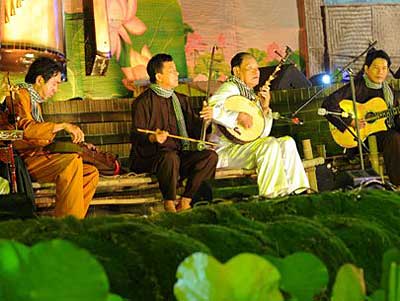The Mekong Delta province of Bac Lieu will host a national festival featuring the UNESCO-recognized performing art of Don ca tai tu from April 20 to 25. There will be 21 art troupes from 21 southern provinces taking part in the event.
Don ca tai tu has just been recognized as an intangible cultural heritage of humanity by UNESCO, taking to eight the total number of Vietnam’s intangible cultural heritages.

Following this recognition, the southern provinces have rolled up their sleeves in a joint bid to fulfill their commitment to UNESCO in safeguarding and promoting unique values of Don ca tai tu.
Bac Lieu and other southern provinces will also take this great opportunity to introduce their charming images characterized by rivers and canals, and decent and generous traits of southerners.
A number of tourist attractions in Bac Lieu are getting ready to welcome domestic and foreign visitors. Also, a lot of families there who have Don ca tai tu performing skills have been practicing together with the province. Many other Don ca tai tu clubs in the communes of Dong Hai and Phuoc Long are joining the effort to help draw tourists and visitors.
The Bac Lieu Department of Culture, Sports and Tourism, in collaboration with the Mekong Delta Tourism Association, has introduced the festival to travel agencies.
Don ca tai tu is a musical art that has both scholarly and folk roots and is a popular cultural activity that serves individuals and communities. It resonates with the lifestyle of southerners who work on the fields and in the rivers of the delta. It reflects their inner feelings and emotions, their industriousness, generosity and courage.
The art developed in southern Vietnam in the late 19th and early 20th centuries, and originated from musicians during the Nguyen Dynasty, who followed Can Vuong Movement to the southern region.
Nguyen Quang Dai (a.k.a. Ba Doi) in Long An, Tran Quang Quon (a.k.a. Ky Quon) in Vinh Long, Nguyen Trong Quyen (a.k.a. Moc Quan) in Can Tho, Le Tai Khi (a.k.a. Nhac Khi) and Su Nguyet Chieu in Bac Lieu are all well-known and respected Don ca tai tu musicians.
People in the country’s south consider Don ca tai tu an indispensable spiritual cultural activity and a highly valued part of their cultural heritage as it connects people by expressing respect and harmony between different communities, groups and individuals.
It is played with a variety of instruments including kim (moon-shaped lute), co (two-stringed fiddle), tranh (16-string zither), ty ba (pipa), song lang (percussion), bau (monochord) and sao (bamboo flute), violin and guitar. The guitar for this art has a deep, hollowed-out finger board, enabling musicians to play special ornamentation characteristic of Don ca tai tu.
Bac Lieu is home to many celebrated musicians such as Sau Lau, Muoi Khoi, Ba Chot, Hai Thom, Ba Lat, Bay Kien, and Bay Cao.
The repertoire of Don ca tai tu is based on 20 principal songs (bai To) and 72 classical songs (bai nhac co). These songs consist of ‘skeletal melodies’ which are used as the basis for improvisation and variation. Don ca tai tu performers express feelings and sentiments by improvising, ornamenting and changing the ‘skeletal melody’ of pieces and the main rhythmic patterns.
In the early 20th century, Cao Van Lau (a.k.a. Sau Lau) composed Da o hoai lang which is the most famous song of Don ca tai tu. The structure of this piece changed as it was transmitted over time: its rhythmic structure changed from using 2-bar phrases, to 4-bar, 16-bar, 32-bar and 64-bar phrases.
Bac Lieu now has 158 Don ca tai tu clubs with more than 1,676 members. Its Department of Culture, Sports and Tourism annually holds a local festival for Don ca tai tu artists and musicians from Bac Lieu, Soc Trang, Ca Mau and other southern provinces to participate.
This is an essential job to uphold and promote the art in southern Vietnam.